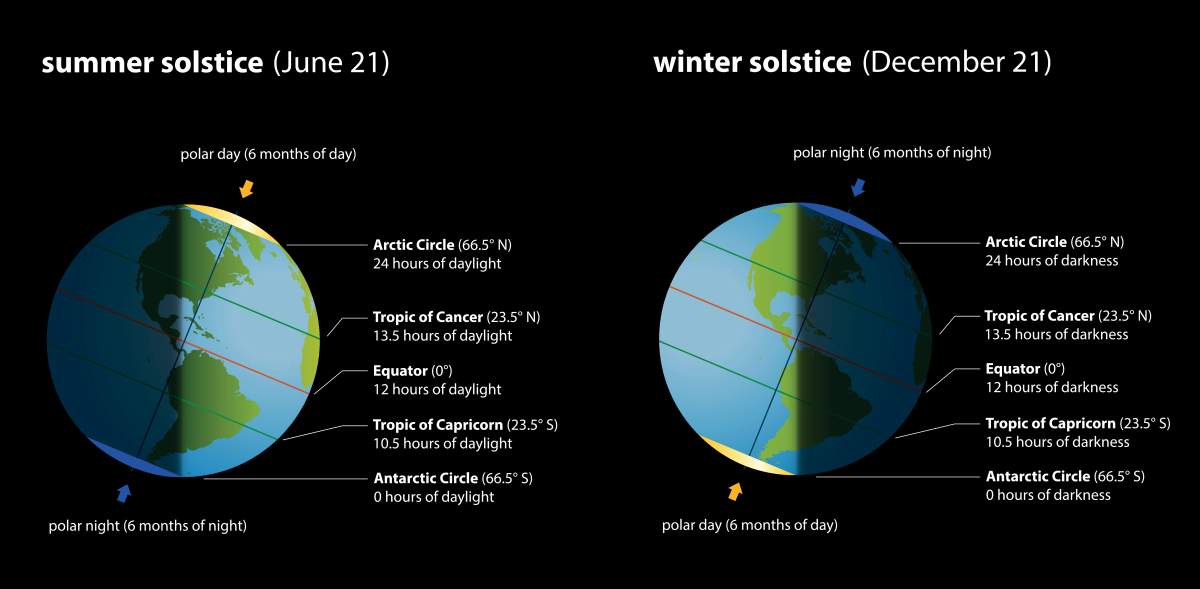The winter solstice officially happens late Friday afternoon, marking the first day of winter for the Northern Hemisphere and also the shortest day of the year.

But if you’re dreading the cold dark nights, fear not: after the winter solstice, the days slowly start getting longer and the nights shorter — the start of a steady climb toward summer.
This solstice year also corresponds with a full moon, known as the Cold Moon, and a meteor shower. The next time a full moon lines up with the winter solstice will be 2094 — so you may want to pop your head out the window and take a peek.
WATCH BELOW: Hundreds participate in nude swim to mark winter solstice in Australia
When does the winter solstice officially start?
The winter solstice start at 5:23 p.m. ET Friday.
Because the Earth is divided into 24 times zones, people around the world will observe it at 24 different times of the day.
IN PHOTOS: From Krampus to bears, holiday traditions from around the world
The solstice usually occurs every Dec. 21, however, the time that it happens and the day it lands on can change because the solar year (the time it takes for the sun to reappear in the same spot as seen from Earth) does not exactly match our calendar year.
A solar year is approximately 365.242199 days but varies from year to year because of the influence of other planets. The Gregorian calendar, which is used in most western countries, has 365 days in a common year and 366 days in a leap year.
Why do solstices happen?
The winter and summer solstices happen simply because the Earth spins on a tilted axis. As a result, Earth’s northern and southern hemispheres trade places in receiving the sun’s direct light and warmth.
What is the science behind the winter solstice?

Get daily National news
The December solstice happens when the sun is at its most southerly position, directly overhead the Tropic of Capricorn (when the North Pole is tilted furthest away from the sun).
The lack of exposure of the sun’s rays makes the winter solstice the darkest day of the year.
How much sunlight will you get?
This depends on where you live. If you live in the northern hemisphere, it means this will be the day with the fewest hours of daylight. The further north you live from the equator, the less sunlight you will have.
For example, Fairbanks, Alaska, will get less than four hours of daylight during this time. Here is a time-lapse video that shows how little sun the city gets during the winter solstice.
North of the Arctic Circle towards the North Pole, there is no direct sunlight at all during this time of the year.
However, if you live in the southern hemisphere, it means it’s the summer solstice and the longest day of the year.
Does the winter solstice have anything to do with Stonehenge?
The purpose of Stonehenge, which was built around 5,000 years ago, still remains a mystery. However, there are theories that it was designed to align with the sun, according to Salisbury Stonehenge Tours.
During the winter solstice, the structure is directly ailed toward the sunset (during the summer solstice, the sun rises over the structure’s Heel Stone and hits the Alter Stone in the centre).
This is why, every year, thousands of people flock to the prehistoric site to see the sun rise and set.
Is there a Christmas connection?
During Roman times, a day called Saturnalia was held in mid-December, and was an ancient pagan festival honouring the agricultural god Saturn, according to History.com. And many of the celebrations that took place during this time are now used as Christmas traditions.
The celebration of the holiday Saturnalia came from older farming-related rituals of midwinter and the winter solstice, especially the practice of offering gifts or sacrifices to the gods during the winter sowing season.
According to the BBC, during Saturnalia, homes were decorated, parties were thrown and slaves did not have to work and were allowed to participate in the festivities — it was a season of goodwill.
“The Christian Church appropriated quite a few Pagan festivals and Pagan activities,” Sam Moorhead with the British Museum told BBC.
There are other winter solstice traditions that correspond to Christmas celebrations.
Scandinavians once celebrated Jól or Yule, a multi-day feast marking the sun god’s return. In Britain, Druids (part of the ancient Celtic culture) celebrated the winter solstice by cutting the mistletoe from a tree with a golden sickle.
What about the Cold Moon and meteor shower this year?
December’s full moon is known as the Cold Moon and takes place on Dec. 22 at 12:49 p.m. ET, according to NASA. It’s also known as the Long Night’s Moon because it typically happens near the winter solstice.
The last time the full moon lined up this closely with the winter solstice was in 2010, and the next time this will happen will be in 2094.
WATCH: Massive ‘cold moon’ celebrated by skygazers around the globe in 2017

This also falls during the peak of the Ursid Meteor Shower, which takes place on the heights of Dec. 21 and Dec. 22. According to AccuWeather, it’s only a “minor” meteor shower, and you may be able to see up to 10 shooting stars per hour.












Comments